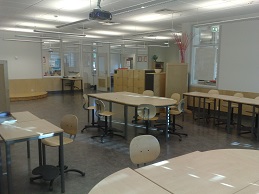Adapted education in different school architecture
DOI:
https://doi.org/10.7577/formakademisk.520Keywords:
adapted education, school architecture, open-plan schools, traditional schools, access to teaching space, differentiation, collaboration and autonomyAbstract
In this article I have made an inquiry into different teachers’ experiences with, perceptions about and preferences regarding two different types of school architecture. The article is based on observation and interviews with seven teachers. Three of these teachers worked in an open-plan school (baseskole), while the other four worked in a school with traditional classrooms. The teachers told stories about the connection between the school architecture and the possibilities they felt they had for teaching according to their own pedagogical views. They pointed out three central areas that were of importance for this connection. All of these areas can be seen in the light of the expression: adapted education. The first area was regarding the type of differentiation that was considered to be the starting point for adapted education at the school, and how the physical structures in the school correlated with the chosen type of differentiation and organizing that were put to use there. Regarding this area, the teachers from both schools were very satisfied. A second area of importance was the actual access to teaching space as a starting point for using different teaching strategies and methods. Regarding this area, the teachers from the traditional school were very satisfied, while the teachers from the open-plan school felt the rooms they had for teaching sat limitations upon different aspects of their teaching practices. The last area the teachers pointed their fingers at, was how the physical structures made possible a desired balance between close collaboration with colleagues and autonomy in situations regarding planning and teaching. The teachers from both schools were pretty satisfied regarding this area, but they had different preferences to how this balance should be.

Downloads
Published
How to Cite
Issue
Section
License
Authors who publish with this journal agree to the following terms:
- Authors retain copyright and grant the journal right of first publication with the work simultaneously licensed under a Creative Commons Attribution 4.0 License that allows others to share the work with an acknowledgement of the work's authorship and initial publication in this journal.
- Authors are able to enter into separate, additional contractual arrangements for the non-exclusive distribution of the journal's published version of the work (e.g., post it to an institutional repository or publish it in a book), with an acknowledgement of its initial publication in this journal.
- Authors are permitted and encouraged to post their work online (e.g., in institutional repositories or on their website) prior to and during the submission process, as it can lead to productive exchanges, as well as earlier and greater citation of published work (See The Effect of Open Access).
- The author(s) must manage their economic reproduction rights to any third party.
- The journal makes no financial or other compensation for submissions, unless a separate agreement regarding this matter has been made with the author(s).
- The journal is obliged to archive the manuscript (including metadata) in its originally published digital form for at least a suitable amount of time in which the manuscript can be accessed via a long-term archive for digital material, such as in the Norwegian universities’ institutional archives within the framework of the NORA partnership.
The material will be published OpenAccess with a Creative Commons 4.0 License which allows anyone to read, share and adapt the content, even commercially under the licence terms:
This work needs to be appropriately attributed/credited, a link must be provided to the CC-BY 4.0 licence, and changes made need to be indicated in a reasonable manner, but not in any way that suggests that the licensor endorses you or your use.



